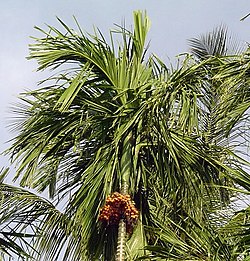| Arecales Temporal range: Late Cretaceous - Recent | |
|---|---|
 | |
| Areca catechu | |
| Scientific classification | |
| Kingdom: | Plantae |
| Clade: | Tracheophytes |
| Clade: | Angiosperms |
| Clade: | Monocots |
| Clade: | Commelinids |
| Order: | Arecales Bromhead |
| Families | |
| Diversity | |
| 206 genera | |
Arecales is an order of flowering plants. The order has been widely named as such only for the past few decades; until then, the accepted name for the order including these plants was Principes. The order includes palms and relatives.
